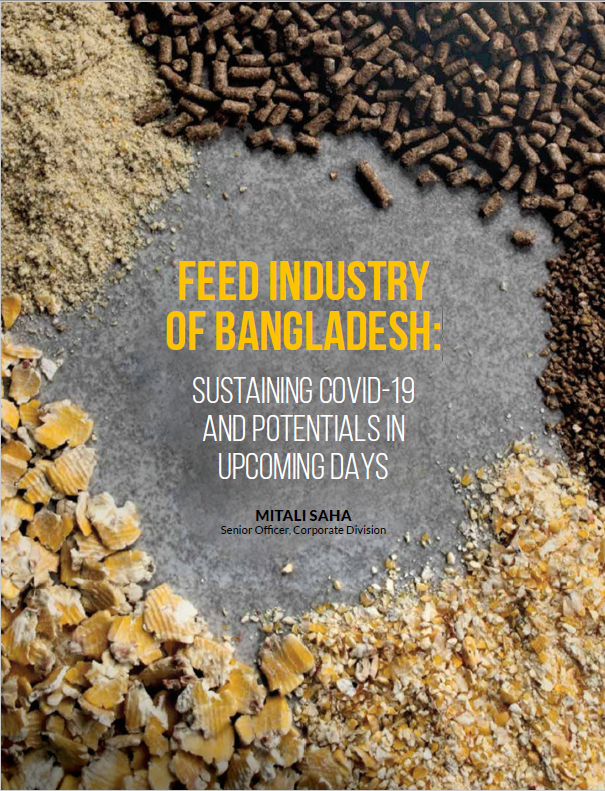
FEED INDUSTRY OF BFEED INDUSTRY OF BANGLADESH: SUSTAINING COVID-19 AND POTENTIALS IN UPCOMING DAYSANGLADESH: SUSTAINING COVID-19 AND POTENTIALS IN UPCOMING DAYS
MITALI SAHA Senior Officer, Corporate Division
Agriculture has been considered as the core sector of the economy from the very inception of Bangladesh. Poultry-cattle rearing and fishing have become the integral part of Bangladesh’s agro-based economy and rural livelihood. According to the report of Bangladesh Bureau of Statistics 2019-20, agricultural sector is contributing 13.35% in our GDP out of which 4.95% is added by this poultry and fisheries section. To meet the huge protein demand of our country, feed mills are playing a pivotal role by producing quality feeds.
Global Feed Industry - At a Glance
The largest and most vital component to ensure safe and affordable animal proteins is feed. According to International Feed Industry Federation (IFIF), global commercial feed manufacturing generates an annual turnover of around US$400 billion from compound annual feed production of 1 billion tonnes. More than 130 countries are involved in commercial production or sale of manufactured feed products which creates direct employment of many skilled workers, technicians, managers and professionals. We are seeing continued enhancement in the demand for animal protein especially livestock and fish worldwide over the past couple of years. The production growth of feed products is more or less constant in developed counties while it has been increased in the developing countries. A snapshot of global compound feed production for the year of 2018 is provided below.

Lockdowns, logistical blockages and rumors have affected the feed market
Lockdowns was announced to control the coronavirus pandemic in many regions around the world, which affected the movement of vehicles carrying livestock, feed, and feed ingredients. Also, the poultry industry was battling rumors of coronavirus spreading through the consumption of poultry, meat and meat products. Moreover, raw material price volatility was a major challenge faced by feed manufacturers worldwideduring the pandemic.
Supply chain disruptions leading to a loss in dairy and meat products have affected the feed market
Due to the COVID-19 pandemic, the demand for basic food or essentials had been on the rise. Despite the strong demand for meat, dairy, and aquaculture products amidst the pandemic, the supply chain had witnessed a host of disruptions, which stopped producers from providing their products in the market. For instance, disruptions in the supply chains caused wastage of fresh produce in the US, even though there were a high demand and food shortage for dairy produce. Consequently, the Dairy Farmers of America (market leader in the dairy industry in USA), had to ask farmers to dump their milk. Also due to the emerging threats from the spread of the pandemic, the global export of beef and chicken meat trade has reduced significantly which subsequently affected the feed market.
Impact on Meat and Fish Market
The combination of COVID-19 related economic hardships, logistical blockages and a sheer decline in demand from the food services sector due to lockdowns has led to a global slump in import demand, causing international meat prices to fall, with the sharpest drop registered for ovine meat, followed by poultry, pig and bovine meats as well as fish and fishery products. Governments around the world seeking to contain the virus have introduced isolation directives, limitations on business opening hours, and travel restrictions. Food-service demand has been sharply reduced as restaurants have closed, although retail sales of nonperishable products, such as canned tuna, have seen a boost as households changed their purchasing behavior. Plummeting food service sales have resulted in meat stock accumulation, especially premium categories, and in bulk packaging, enlarging export availabilities and weighing on international meat prices, despite a decline in meat output caused by labor shortages in slaughterhouses, processing and packing due to the epidemic. An overview of production and trade volume of meat and fish market is provided below:

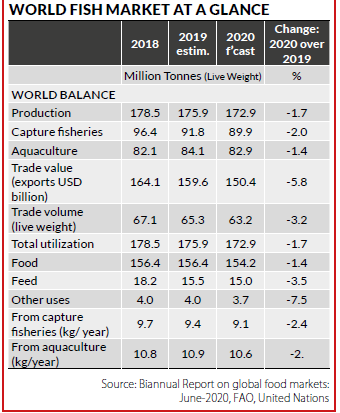
Post Pandemic scenario analysis of Global Feed Market
Despite a significant negative impact of COVID-19, the global feed market size is estimated to grow from USD 282.8 billion in 2020 and projected to reach USD 289.0 billion by 2021, recording a compound annual growth rate (CAGR) of 2.2%. Upgrading and modernization of the livestock industry, the growing awareness about livestock nutrition and increasing consumption of meat and other livestock-based products have led to surge the market size of feeds and feed additives. Conversely, feed manufacturers and producers have become more aware of different techniques and strategies to cope up with the situation aroused due to COVID-19. An analysis of post COVID-19 impact on global feed market is provided below:
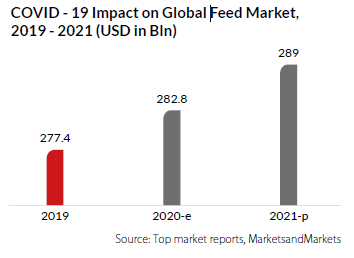
Feed Mill Industry in Bangladesh-At a Glance
Over the last two decades, large poultry, cattle and fish farms involved in commercial production have been gaining prominence. Commercial feed production experienced almost 25% growth in last one decade due to the augmented protein demand, which results the launch of many commercial feed mills over the past couple of years. A snapshot of feed mills in Bangladesh is provided below.
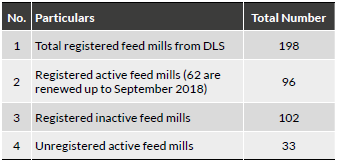
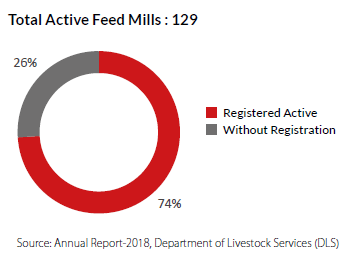
Top feed mills like Nourish Poultry Feeds, ACI, Kazi Farms, Provita Feed, Aftab Feed, New Hope Feed, Aman Feed etc. are occupying about more than 70% of total market share. A glimpse of market coverage of top feed mills is provided below:
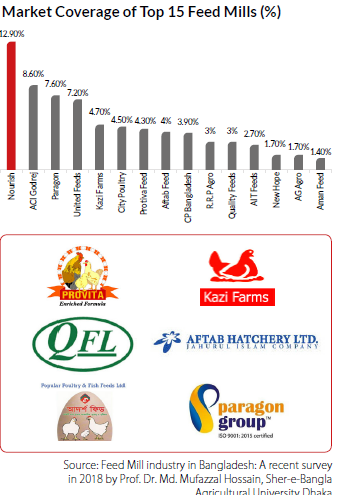
Categories of Feed and Current Market Demand in Bangladesh
As per Ministry of Fisheries and Livestock of Bangladesh (MoFL), the per capita meat consumption of an average Bangladeshi is amounted to be 45.62Kgs. More than six million people in our country are directly or indirectly involved in poultry and fish production. In Bangladesh, the market size of total commercial feed stands to be at 5.03 MMT (million metric tons) with an estimated market turnover of US$ 2.5 billion. Bangladesh’s commercial feed industry can be divided into three broad categories. Each category can be divided into two sub categories.
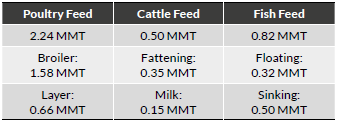
Market Share by Category
Poultry Feed (Broiler) currently holds the strongest position in the market with a monumental share of 44% out of total 63%. The sub-segment in the second position also belongs to the poultry group; Layer Poultry Feed holds 19% of the total market. Rest 23% and 14% are held by fish and cattle feed respectively.
Impact of COVID-19 on Feed Industry of Bangladesh
The pandemic has hit this sector drastically. Feed sector is considered to be a critical industry during the COVID-19 pandemic and this outbreak threats the
sustainability of the entire value chain of the livestock industry under questionable impression. Foremost implications on this sector due to COVID-19 are mentioned below:
Due to some groundless rumors which spread specially through social media that the corona virus could be transmitted to people through livestock and livestock products, caused serious damage in this sector. Market demand decreased suddenly and production also halted caused by fears from the unfounded rumors as well as people’s decreased incomes and their inability to access markets. This eventually will lead to a financial crisis for farmers and other stakeholders in the supply chain.
Significant portion of the Active Pharmaceutical Ingredient (API) used for animal medicine in our country is imported from other countries. Due to international arrest of transactions, the supply of API is about to witness an abrupt fall resulting in a shortage of supply of animal medicines for the sector.
Soybean and maize are main raw materials of animal feed. Out of total consumption, about 50- 60% of the maize and 40% of soybean are sourced internationally. The import scenario is most likely to remain stagnant during this ongoing pandemic, which is causing a crisis of raw materials for animal feed nationally.
As the number of animal production operations is hampered, the number of animals slaughtered and processed will also decrease. Insufficient workforce, inadequate delivery and transportation facilities will also play a major role in the decline of growth in this sector.
Due to low consumption, price hike of major ingredients of feed and insufficient supply of raw materials, sales of most feed will face a drop off this year which will encumber the overall growth of the feed industry.
The price of DOC, eggs, poultry, meat, and dairy products has started declining at the wholesale level due to the hindrance in the supply chain of livestock and poultry products. Small and medium businesses incurring a substantial loss are combating their sustainability in the industry in the long run.
Insufficient supply of raw materials, price fluctuation and supply demand instability also leading a significant negative impact on forward and backward linkages of poultry and fisheries businesses.
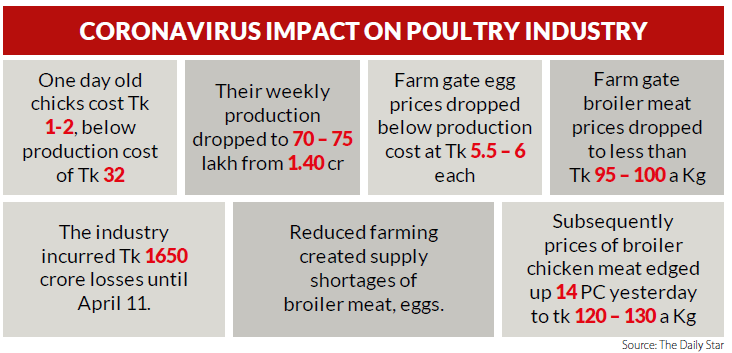
Historical and Present Market Price Situation
Some main ingredients which are required to produce feed are soybean, maize, fish meal, rapeseed etc. Bangladesh is not self-sufficient in producing these raw materials. Local producers are heavily dependent on imports from countries as India, Brazil and USA. Moreover, micro ingredients and other nutritional premixes are entirely imported from other nations.
Major Raw Material Prices (Before and after lockdown current scenario)
Due to the pandemic, prices of most raw materials increased as there were supply shortage due the import barrier and others issues. Before and after pandemic average prices of some major imported materials are provided below:
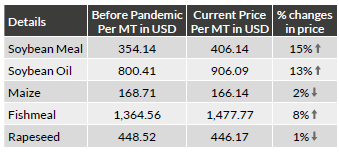
Finished Goods Prices (Before and after lockdown current scenario)
As value of raw materials hiked due to pandemic, price of different feed products also changed during the period. Price variation of most common and widely sold feed products is provided below:
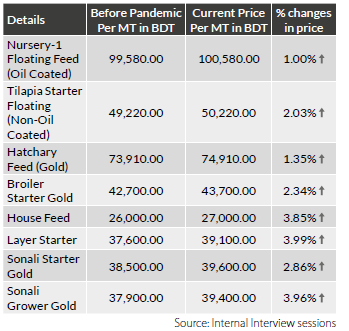
Combating Against the Pandemic
The feed industry is a crucial part of the agricultural sector which ensures the supply of protein for human beings. Amid the pandemic, this sector is subject to facing privation. And it will not be exaggerated if we say that, with the fall of this sector, the whole nation would be looking at an economic downfall. So, now we need to be more prepared and cautious to protect this sector.
Department of Livestock Services (DLS) and
Ministry of Fisheries and Livestock (MoFL) are
providing support in distributing and marketing
eggs and poultry. MoFL is also supporting for the
early release of imported items of poultry & fish
feed and pharmaceutical products from the seaport.
Government has declared a stimulus package of BDT 5,000 crore (US$595 million) to provide financial assistance to farmers in rural areas and different small and medium businesses for boosting agricultural production as well as economy revitalization. Regulators and banks should work together in distribution of government declared stimulus package so that the fund can reach to the right place.
As major portion of raw materials of feed is imported, interruption in the import-export businesses will create a crisis in this sector. Department of Agricultural Marketing (DAM) can play a vital role to overcome this crisis in both Covid-19 and post-Covid-19 situations. DAM is already buying perishable products from farmers and middle men, and also distributing them to the required areas.
Digitization will also help this sector to survive and step up in the next level. Innovative measures such as establishing data center with list of potential buyer and sellers and digital platforms to match farmers and medium feed businesses with potential buyers in case of product surplus will facilitate the development of this sector.
In order to survive in this global pandemic of COVID-19, this sector is in dire need of policy reforms and support from the government. The regulators must work in reducing the supplydemand deficit throughout the value chain. Also the government should raise awareness in clearing the misconceptions in the mind of consumers.
Prospects in Upcoming Days
The growth opportunity for the feed market in our country is immense. This industry can provide various opportunities to increase GDP growth rate and equitable distribution through arranging food security as well as ensuring self-employment, creating purchasing power and reducing poverty at a large scale
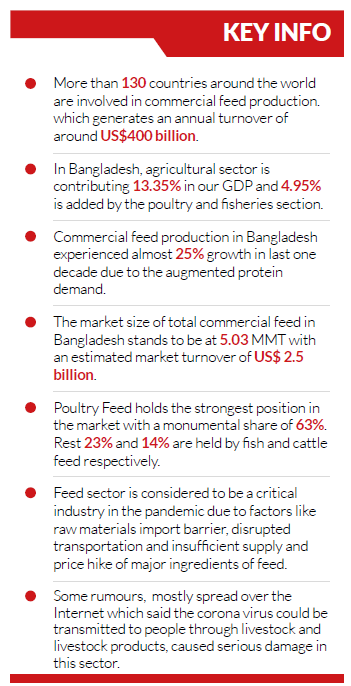
As Bangladesh is one of the high density countries of the world with a population of 160 million, the demand of feed products will increase continuously to meet the huge protein requirement of the people. The major portion of this increasing demand for feed items will have to be met by mechanized feed millers whereas the home-mix producers will have to take care of the rest. As major portion of our population of this country still live in villages and are extremely poor, both the government and a variety of non-government organizations (NGO’s) are actively promoting poultry and cattle farm development at all levels to help the low income people and create new employment. Thus demand for feed products will increase as feed market works as the backward linkage of the poultry, livestock, and fisheries industries. Food businesses have gained popularity in our country for the last couple of years. Many restaurants were established throughout the country, especially in the urban areas. Though the food and restaurant business have struggled a lot during the pandemic, it is expected that this sector will be able to overcome the hurdle in near future. Since restaurant businesses take up a significant portion of the livestock and poultry industry, the growth of restaurant industry will help the feed industry to scale up in future. Busy lifestyle in the urban areas and increasing participation of women in the workforce have contributed to the growth of processed and convenience foods business. Since this sector is linked to livestock industry and lies at the forward position in the value chain, the progression of the frozen food market will influence the growth of feed industry as well.
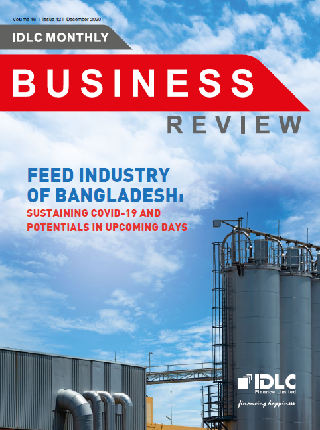
Feed Industry of Bangladesh: Sustaining Covid-19 and Potentials in Upcoming Days
Feed Industry of the country: Surviving the Outbreak of COVID-19
The agricultural industry of Bangladesh remains of pivotal importance, contributing 13.35% to the GDP of the country. Out of this, 4.95% is contributed by poultries and fisheries, which would not have been possible without proper nutrition provided by the feed mills. This establishes the far-reaching importance that feed mills hold in ensuring quality output from the agricultural sector. Globally, the feed industry generates about US $400 billion from compound annual feed production of 1 billion tonnes. Over 130 countries are involved in the production process or sale of feed which generates employment opportunities for many.
In an obvious attempt to contain the virus, governments all over the world, introduced lockdowns, limitations on travel and business opening hours. All of these has had an unnerving impact on the feed industry alongside many others. Lockdowns and logistical blockages have created movement restrictions, halting business activity. And no just that, even rumors concerning the spread of coronavirus through poultry and other meat consumption has had a significant impact on the industry’s turnover. Supply chain disruptions leading to a loss in dairy and meat products have affected the feed market as well. Disruptions in the supply chain created wastage despite high demand in the markets, and trade halts have stopped raw materials from coming into the country which had severely impacted the feed mills industry and its stakeholders.
However, lockdowns have given a lot of people time to reflect on many decisions and directed them towards taking healthier steps, for instance. The increased consumption of meat, alongside growing awareness about livestock nutrition has led to an expansion of the market size of feed and feed additives globally. In Bangladesh, commercial feed production experienced a near 25% growth over the last decade. A number of feed mills were established to meet the upsurge in feed demand and the local market expanded subsequently, with poultry feed holding the most market share, followed by fish feed and then cattle feed.
With the world slowly stabilizing after the impact of the pandemic, the only hope is to look ahead into the future towards a prosperous local and global feed industry, and a safer and healthier world.
Sushmita Saha
Assistant Manager
IDLC Finance Ltd.